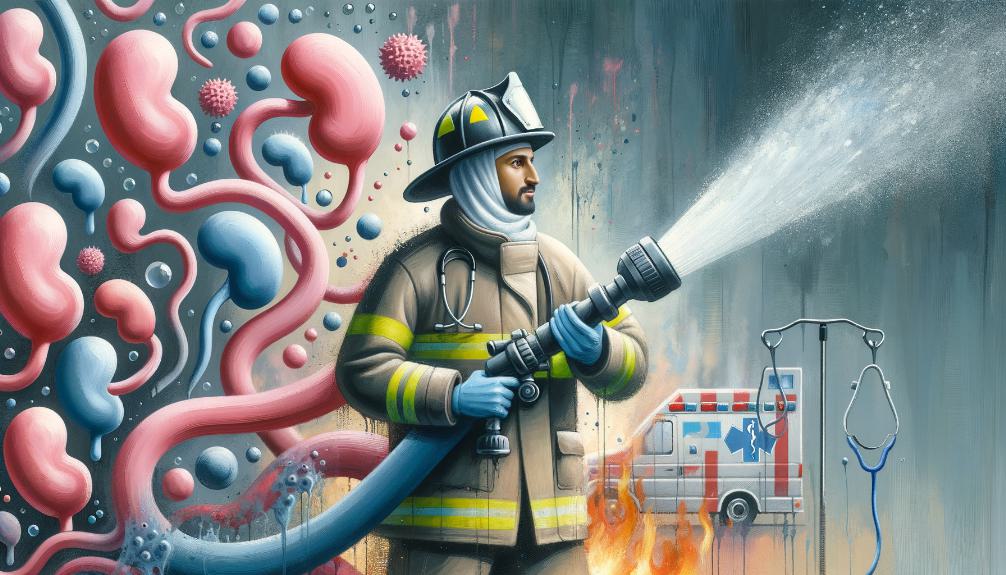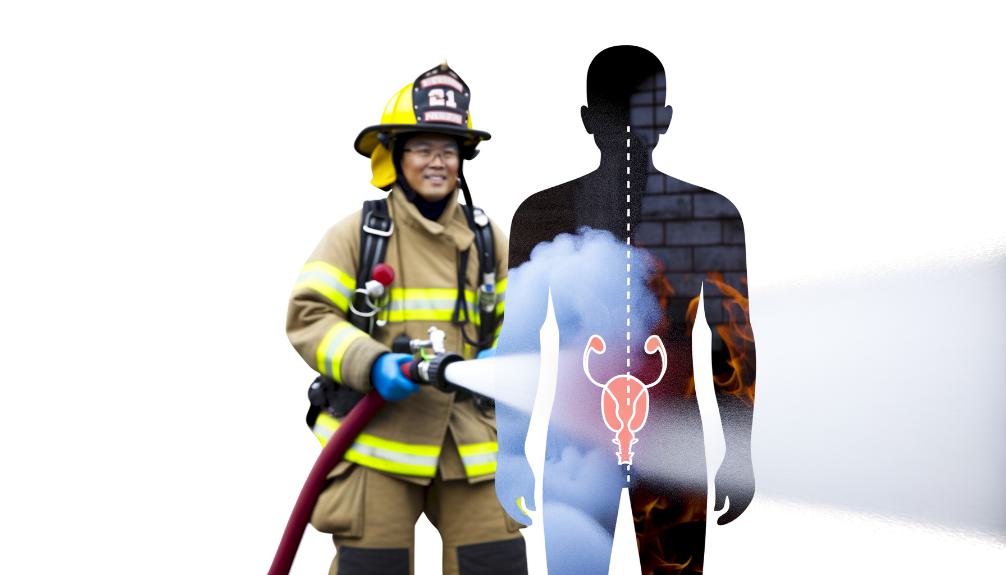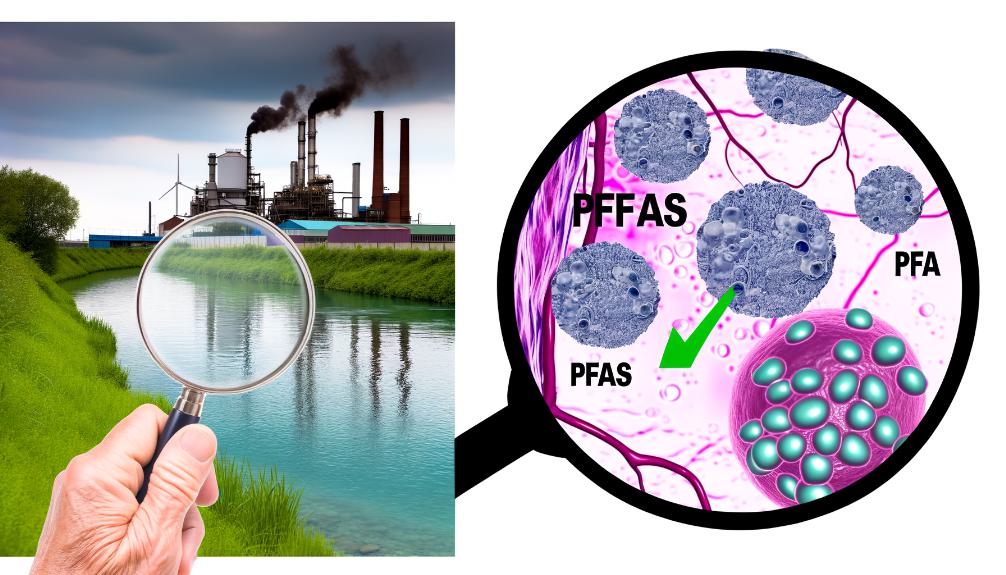Bladder Cancer: Identifying AFFF as the Primary Cause
We've identified that Aqueous Film Forming Foam (AFFF), containing PFAS chemicals such as PFOA and PFOS, is a primary cause of bladder cancer. This link is especially significant among firefighters and military personnel due to their heightened exposure. These PFAS compounds, present in firefighting foam, bioaccumulate in human tissue, increasing cancer risk. With states like California and Michigan banning PFAS-infused AFFF and ongoing legislative efforts to mitigate health risks, understanding the legal terrain for affected individuals is critical. Victims are pursuing compensation through lawsuits alleging negligence by AFFF manufacturers. By exploring further, one will uncover the complexities of such legal battles and the importance of expert guidance.

Key Takeaways
- Firefighters exposed to AFFF containing PFAS have an increased risk of developing bladder cancer.
- PFAS compounds like PFOA and PFOS in AFFF bioaccumulate, elevating long-term cancer risks.
- Persistent exposure to AFFF at military bases and firefighting sites leads to significant PFAS contamination.
- Symptoms such as hematuria and persistent urinary tract infections can be early indicators of bladder cancer linked to AFFF exposure.
- Legal actions against AFFF manufacturers highlight the link between PFAS exposure and bladder cancer.
Understanding AFFF

Aqueous Film-Forming Foam, or AFFF, is a firefighting foam that's become infamous for its use of PFAS, known as 'forever chemicals,' which have been linked to serious health and environmental risks. We've seen AFFF employed to extinguish flammable liquid fires, yet its composition, particularly the inclusion of PFAS compounds like PFOA and PFOS, presents alarming concerns. These 'forever chemicals' not only persist in the environment but also accumulate in human bodies, posing significant health risks, including cancer.
The link between AFFF and various health issues, especially cancer, has been increasingly scrutinized. The persistence of PFAS chemicals in water and soil exacerbates their impact, leading to widespread environmental contamination. This contamination isn't a fleeting issue; it's a persistent one, with PFAS compounds contributing to long-term water pollution.
Aware of these dangers, states such as California, Michigan, and Vermont have taken decisive action by implementing bans on AFFF containing PFAS. These bans represent a critical step toward mitigating the health risks and environmental damage caused by these chemicals. However, the prevalence of AFFF and its role in firefighting poses challenges in completely eliminating its use.
As we explore the complexities of AFFF, it's clear that the path forward requires a careful balance between ensuring firefighting effectiveness and protecting public health and the environment. The ongoing legislative efforts to ban PFAS-containing AFFF reflect a growing consensus on the need to address these serious concerns. Moving forward, it's vital that we continue to monitor the impact of these bans and seek alternatives to AFFF that do not compromise on safety or environmental integrity.
PFAS Toxicity Explained
At the core of AFFF's harmful impacts lies the toxicity of PFAS compounds, which, due to their enduring nature, can accumulate in the human body over time, leading to severe health issues including bladder cancer. These so-called 'forever chemicals', especially PFOA and PFOS found in AFFF, are infamous for their persistent presence in the environment. Their strong chemical bonds allow them to withstand natural degradation processes, posing important health risks as they bioaccumulate in human tissue through repeated exposure.
The toxicity of PFAS compounds is a critical concern because of their ability to leach into groundwater, contaminating our primary sources of drinking water and persisting in ecosystems. This contamination route exposes a large segment of the population to these harmful chemicals, increasing the likelihood of health issues. Over time, PFAS exposure, particularly from AFFF, can lead to changes in bladder tissue cells. This alteration greatly raises the risk of developing bladder cancer, a concern that underlines the seriousness of addressing PFAS contamination.
Understanding the dangers PFAS pose is essential for protecting public health. The bioaccumulation of these compounds in the human body, coupled with their persistent nature, underscores the urgent need for strategies to manage and mitigate AFFF exposure. Reducing this exposure is crucial in preventing the accumulation of PFAS in groundwater and, by extension, our bodies, thereby lowering the health risks associated with these hazardous chemicals.
Firefighters at Risk

We're facing a critical reality where firefighters, due to their exposure to AFFF containing harmful PFAS chemicals, are at a significantly increased risk of developing bladder cancer. The data reveals that firefighters confront a majority higher cancer risk, mainly due to their interaction with AFFF, which is laden with toxic PFAS chemicals such as PFOA and PFOS. These specific compounds have been directly linked to an elevated incidence of bladder cancer among our brave firefighters. With over 5,000 PFAS chemicals present in AFFF, the complexity and magnitude of the risk they pose cannot be overstated.
Bladder cancer, a significant health concern for firefighters, is exacerbated by their frequent exposure to these dangerous chemicals. The statistics are alarming, with more than 81,000 bladder cancer diagnoses projected in 2022 alone, many of which are connected to firefighters' exposure to AFFF. This stark figure underscores the urgent need for measures to mitigate this risk and provide adequate compensation for those affected.
The plight of firefighters emphasizes the broader, devastating impact of PFAS contamination, which extends beyond the firefighting community. However, it's vital to focus on the immediate need for enhanced protective measures for these frontline heroes and the establishment of a fair compensation framework. As we continue to uncover the full extent of AFFF's dangers, the priority remains clear: safeguarding our firefighters' health and ensuring justice for those who've suffered due to exposure to these hazardous chemicals.
Military Exposure Concerns
Shifting our focus to military bases, it's evident that these sites are significant sources of PFAS contamination, presenting serious exposure risks to both military personnel and surrounding communities. Particularly, military installations such as the Navy and Air Force have been identified as hotspots for such contamination. The use of Aqueous Film Forming Foam (AFFF) in firefighting and training exercises has contributed to the widespread presence of PFAS chemicals, which are recognized for their environmental persistence and potential to bioaccumulate in organisms.
This bioaccumulation implies that PFAS substances accumulate in the body at a rate faster than they can be excreted, leading to increased health risks. Additionally, the environmental persistence of these chemicals at military bases worsens ecosystem contamination, posing further threats to health. Contaminated wells near military facilities are of special concern, as they directly expose military personnel and nearby communities to PFAS, raising alarms over potential health impacts.
The biomagnification potential of PFAS chemicals is another concerning factor. As these substances move up the food chain, their concentration increases, amplifying the health risks to humans and wildlife alike. This is especially concerning for military personnel who, through AFFF exposure, are at a heightened risk of adverse health effects.
Environmental Impact of PFAS

How does AFFF containing PFAS chemicals noticeably alter our environment, affecting both water and soil quality? These compounds, notorious for their environmental persistence, contribute substantially to water and soil pollution. The challenge of remediation is formidable; PFAS compounds are resistant to degradation, making cleanup efforts complex and costly. This resilience in the environment means that PFAS from AFFF can accumulate over time, leading to long-lasting ecosystem effects.
The ecological impact of AFFF contamination is profound. Water bodies and soil affected by PFAS not only suffer from pollution but also pose risks to biodiversity and can disrupt natural habitats. Recognizing the severity of this issue, regulations and restrictions have been implemented to mitigate further environmental damage. These measures aim to control and eventually eliminate the use of AFFF containing PFAS, but the legacy of past contamination still presents a significant challenge.
In response to the extensive environmental damage caused by AFFF contamination, residents and communities have initiated lawsuits against manufacturers. These legal actions seek accountability for the widespread exposure to PFAS and the consequent environmental and health impacts. The litigation underscores the urgency of addressing the remediation challenges posed by PFAS compounds and the importance of stringent regulations to prevent future AFFF contamination.
Signs and Symptoms
We've uncovered that recognizing the early warning indicators and physical changes observed in individuals can be pivotal in diagnosing AFFF-related bladder cancer. These signs, often mistaken for less severe conditions, necessitate a keen awareness for accurate and timely identification. It's imperative we inform on the necessity of early detection measures, including urine tests for PFAS levels, to combat the rapid progression of this disease effectively.
Early Warning Indicators
Recognizing the early warning signs of bladder cancer is essential for timely diagnosis and treatment. Hematuria, or blood in the urine, stands as a common indicator, often prompting further investigation. Persistent urinary tract infections and pain during urination can also suggest the presence of bladder cancer, underscoring the importance of monitoring urinary habits. Changes such as increased frequency or urgency should not be overlooked. Additionally, pelvic pain or discomfort, particularly in the lower back or abdominal area, may hint at this condition. Additionally, unexplained weight loss, fatigue, and loss of appetite are concerning symptoms, potentially signaling advanced stages. Vigilance in noting these early warning signs is paramount in the fight against bladder cancer, urging prompt medical consultation.
Physical Changes Observed
Bladder cancer's physical changes, including blood in the urine and increased frequency of urination, are pivotal signs that shouldn't be ignored. When we notice symptoms like frequent urination, pelvic pain, and that unsettling increased urgency, it's a clear signal to pay attention. More so, if we're experiencing back pain, bone pain, and unexpected weight loss, these could be indications of advanced stages. Difficulty urinating, alongside a noticeable decrease in appetite and enduring fatigue, further compounds our concerns. It's essential we recognize these symptoms early on. The presence of blood in the urine, especially, is a red flag we can't afford to overlook. Early detection through awareness of these signs is important for effective treatment, emphasizing why we must stay informed and vigilant.
Diagnosis and Misdiagnosis

Identifying bladder cancer early is often complex due to a four-year latency period following AFFF exposure, frequently leading to misdiagnosis and delayed treatment. This latency period, typical of bladder cancer due to AFFF, poses significant challenges in timely diagnosis. Symptoms that could directly indicate bladder cancer are often overlooked or attributed to less severe conditions, delaying critical intervention and care.
Blood tests that measure PFAS levels have become a pivotal tool in the early detection of bladder cancer linked to AFFF exposure. These tests can offer a more precise diagnosis, helping to differentiate bladder cancer from other urinary tract or bladder issues. However, the reliance on such specific testing means that without clear indications of AFFF exposure, many individuals, including firefighters and veterans, may not receive these tests promptly.
The misdiagnosis issue highlights the importance of healthcare professionals being aware of the link between AFFF exposure and bladder cancer. Early detection is vital; it not only facilitates better treatment outcomes but also plays a significant role in eligibility for compensation. Firefighters, veterans, and others who have been exposed to AFFF and later developed bladder cancer often face a challenging journey, not just regarding their health but also when dealing with the complexities of compensation for their condition.
We're committed to raising awareness about the critical connection between AFFF exposure and bladder cancer, advocating for improved diagnostic protocols that include PFAS level testing. This effort aims to reduce instances of misdiagnosis, ensuring that those affected receive the timely care and compensation they deserve.
Legal Options for Victims
For those affected by bladder cancer due to AFFF exposure, pursuing legal action offers a pathway to compensation for their suffering. Understanding the legal options available is vital for victims and their families. Personal injury lawsuits are a primary avenue for seeking justice, allowing victims to allege negligence on the part of AFFF manufacturers. These companies failed to warn the public and professionals, including firefighters and military personnel, about the carcinogenic risks associated with their products.
The negligence claims center on the manufacturers' lack of transparency regarding the health hazards of AFFF, despite evidence suggesting they were aware of the risks. Victims can seek compensation for the physical, mental, and economic suffering caused by exposure to this hazardous substance. The legal process, while complex, is manageable with the assistance of experienced firefighting foam cancer attorneys. These professionals are adept at handling the nuances of such cases, ensuring victims' rights are protected throughout.
It's important to note that various occupations are at risk, particularly those involving extensive use of firefighting foams, such as in airports, military bases, and fire departments. These individuals, due to their professional exposure, have a compelling case for compensation claims against the manufacturers.
Our priority is to make sure that victims understand their legal options and the steps necessary to hold responsible parties accountable. While the journey to compensation can be challenging, it's a path worth pursuing for those who've suffered due to AFFF exposure. Our collective effort is to guarantee that justice is served for the victims of bladder cancer linked to this hazardous substance.
Seeking Compensation

As we explore the path to seeking compensation for AFFF-related bladder cancer, understanding our options for legal representation is essential. We must also learn how to accurately calculate compensation amounts, considering all facets of our suffering and losses. This involves a meticulous assessment of medical expenses, lost wages, and the intangible impact on our lives, ensuring we're fully prepared to pursue justice.
Legal Representation Options
We're exploring different legal representation options to seek compensation for bladder cancer caused by AFFF exposure. It's vital to partner with experienced attorneys who understand how to establish AFFF as the primary cause, ensuring those affected have a strong chance at justice. Expert legal teams are invaluable in maneuvering through the complexities of these compensation claims, providing guidance every step of the way. For individuals seeking legal recourse, understanding compensation options is paramount. With the right legal representation, affected individuals can confidently pursue the justice they deserve. Seasoned attorneys are ready to assist, aiming to secure fair compensation for the harm suffered due to AFFF exposure. It's about seeking justice for those impacted, with expert teams leading the charge.
Calculating Compensation Amounts
Having explored legal representation options, it's important to now focus on how compensation amounts are calculated for AFFF-related bladder cancer claims. When it comes to toxic exposure, calculating appropriate compensation amounts involves a thorough examination of not just medical expenses but also lost wages, pain and suffering, and other damages incurred. Legal experts play a pivotal role in this process, evaluating damages and seeking compensation that reflects the financial recovery needed for treatment, rehabilitation, and ongoing care resulting from AFFF exposure. Damages sought also consider the emotional distress, loss of quality of life, and impact on personal relationships, ensuring the compensation amount covers the full scope of economic and non-economic damages suffered due to the toxic exposure.

This post has been generated by AI and was not reviewed by editors. This is Not legal advice. Please consult with an attorney.


![Firefighting Foam Lawsuit [2024]: Were You Or A Loved One Diagnosed With Cancer 22 foam lawsuit cancer diagnosis](https://lawsuitlegit.com/wp-content/uploads/2024/02/foam_lawsuit_cancer_diagnosis-250x143.jpg)

